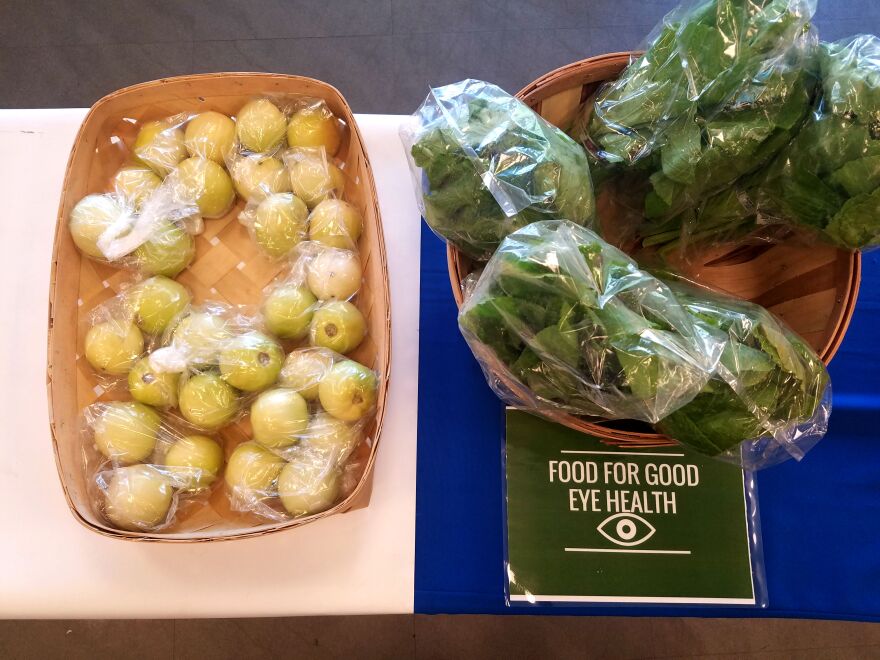An innovative program from Baylor Health Care System and the City of Dallas has been taking on diabetes with common sense. The fix is as simple as fresh fruits and vegetables.
In Dallas’ Frazier neighborhood – just south of Fair Park – fresh produce can be hard to find. But this community, surrounded by fast food chains and corner stores, is starting to turn a little greener.
At the Diabetes Health and Wellness Institute, in Juanita Craft Park, there is a weekly farm stand on Fridays – a room of long tables covered in baskets of fruits and vegetables.
“We have collard greens as well as some mustard greens, and this week we also have green tomatoes,” said David Edwards, a health educator at DHWI. “We have strawberries, cabbage.”
There are also heaps of potatoes and onions, as well as red and black plums, peaches, limes and bananas. There is no shortage of options.
Most items – like a head of cabbage, a bunch of greens or a bag of limes – only cost a dollar. That’s a great deal for families in this neighborhood, where personal income averages about $12,000 annually, and household incomes are just shy of $40,000 a year – and where the nearest full-service grocery store is a Minyards over a mile and a half away. Edwards says factors like convenience and cost are barriers to living a healthy lifestyle.

“You have to make these decisions. ‘Can I eat healthier or do I need to maybe buy what’s in the value meal in the fast food restaurant?’ We want to make this as easy of a decision as possible,” he said.
For residents like Carolyn Liggins, the choice is easy. She filled two large brown-paper sacks with collard greens and mustard greens. She said she comes to the farm stand because it’s the only place nearby that cares about quality.
“When you go to most places, their food [isn’t] so clean and they don’t look great. They looked shriveled all up,” Liggins said. “[The farm stand’s] collard greens look fresh and green and had a good color to them.”

The farm stand is open to everybody – not just patients. And it even takes pre-orders in case customers are unable to shop during peak hours in the morning.
Melva Henderson juggled five bags, stuffed with different fruits. Henderson lives in Oak Cliff and has two kids, whom she’s trying to transition over to a healthier diet.
“They’re pretty big on making smoothies and stuff. This is less expensive so we don’t have to go spend so much money at the grocery story,” Henderson said. “Over where I live, the area is not as convenient with getting those items, so coming here will give me the opportunity to provide that for my children.”
Henderson echoes a lot of the concerns that people in South Dallas have. The Frazier neighborhood, for instance, is what’s known as a “food desert.” That means a full-service grocery store is at least one mile away and not easily accessible to people without reliable transportation.

A 2007 study from the University of Texas at Dallas found that half a million residents across Dallas County were cut off from healthy food – and they were typically from low-income neighborhoods south of Interstate 30. For decades, Dallas has tried to lure grocers to neighborhoods like Frazier – with little success. Recently, the city has even tried offering upwards of $3 million and tax incentives to attract big-box grocers.
“There’s the thing with some of these high-end grocery chains that the customer base isn’t there because they’re looking for a specific median income,” said Tyson Bain, the manager of equitable care for Baylor Scott & White Health, which runs DHWI and its farm stand. “And then for some folks, it’s the security of coming into an area like this where the perception is that it’s not safe.”
What is available then tends to be fast food or processed meals from corner stores packed with unhealthy fats, carbs and additives – what health experts have also termed “food swamps.”
“Folks in those areas are really reliant on those corner stores, these unhealthier options, because that’s all they have access to,” Bain said.

According to Baylor Scott & White Health, people in the Frazier neighborhood have the highest rate of diabetes, heart disease, cancer and stroke in the city. Residents in surrounding ZIP codes are three times more likely to die from diabetes compared to those living elsewhere in Dallas. In addition, hospitalization rates are higher here too – nearly 20 percent higher.
Dr. Donald Wesson, president of DHWI, said since the institute launched in 2010, programs like the farm stand have made strides in reversing those statistics.
“Our analysis shows that the ZIP codes we serve have had fewer hospital admissions and fewer emergency department admissions as a result of the work that we’re doing,” Wesson said.
Hospital admissions have fallen 37 percent, and emergency room visits are down 17 percent. And a 2012 survey of the institute’s members showed nearly half of its patients had achieved the optimal blood glucose level of less than 7 percent.

Along with the farm stand, the institute provides diabetes care, nutrition education as well as cooking and fitness classes. Wesson said successfully combating diabetes and other diseases requires shifting the focus to preventive care.
“So rather than providing what we call sick care – that is waiting until individuals lose their health and we repair their health – we’re creating a community that can do its own health,” Wesson said.
That’ll take time – and reach, he said. The farm stand currently serves about 2,700 people a year. The institute is partnering with local churches to make fresh food even more accessible, and there are plans to expand service into other North Texas neighborhoods.
The hope is that with the right food and resources, diabetes will become a thing of the past.




